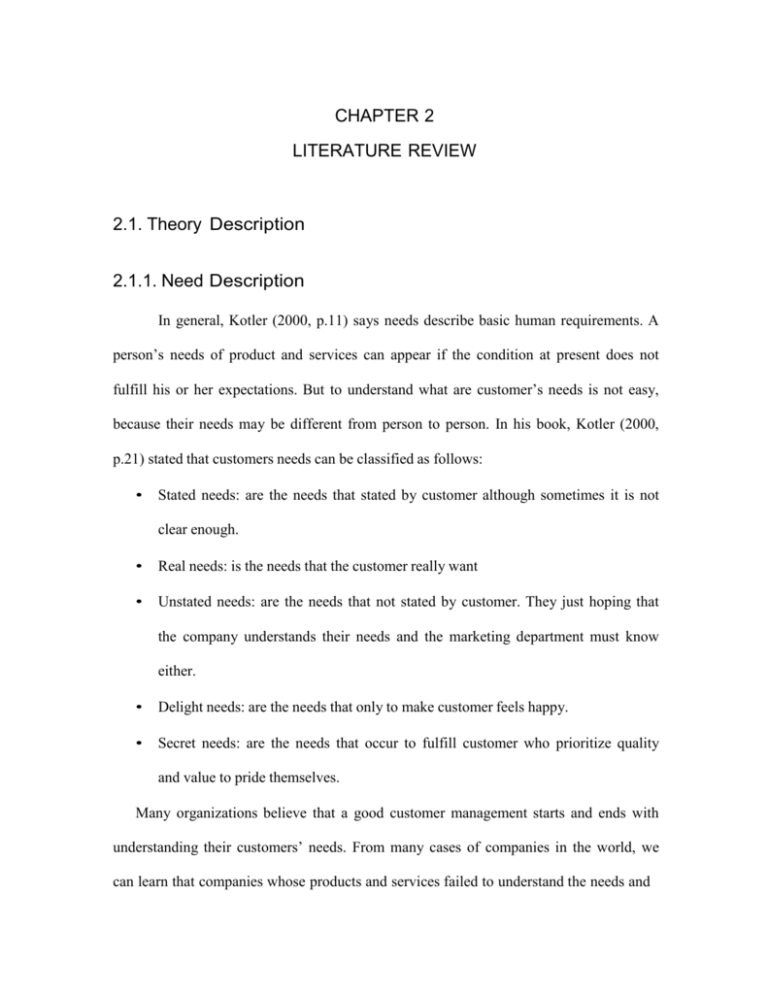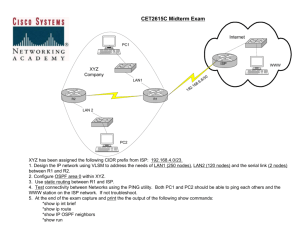chapter 2 - Library & Knowledge Center
advertisement

CHAPTER 2 LITERATURE REVIEW 2.1. Theory Description 2.1.1. Need Description In general, Kotler (2000, p.11) says needs describe basic human requirements. A person’s needs of product and services can appear if the condition at present does not fulfill his or her expectations. But to understand what are customer’s needs is not easy, because their needs may be different from person to person. In his book, Kotler (2000, p.21) stated that customers needs can be classified as follows: • Stated needs: are the needs that stated by customer although sometimes it is not clear enough. • Real needs: is the needs that the customer really want • Unstated needs: are the needs that not stated by customer. They just hoping that the company understands their needs and the marketing department must know either. • Delight needs: are the needs that only to make customer feels happy. • Secret needs: are the needs that occur to fulfill customer who prioritize quality and value to pride themselves. Many organizations believe that a good customer management starts and ends with understanding their customers’ needs. From many cases of companies in the world, we can learn that companies whose products and services failed to understand the needs and requirements of their customer might fail in their business. Another author, Peters (1994, p.46) explains, if a company wants to get a complete understanding of their customers’ needs, there are three main issues involved. There are : 1. Understanding near and long-term customer requirements In this area companies need to consider the market segmentation by studying the situation and collecting information about product and service features. All of the information learned from the findings must be compared in order to optimize successes in the future 2. Projecting future customer requirements and expectations. In this area companies need to consider the time horizon for the determination, understand the external factor, which would influence customers, study the competitors and develop new product and services. 3. Determining customer requirements. In this area companies need to prepare condition for new market opportunities in accordance with time determination. 2.1.2. Customer Satisfaction In the world of competition today, companies are trying to find out how to win customers and outperforming competitors. According to Kotler (2000, p.36) customer will buy products and services from the company that can satisfy them. In general, satisfaction can be described as “a person’s feelings of pleasure or disappointment resulting from comparing a product’s perceived performances in relation to his or her expectations”. If the satisfaction level falls, customer is dissatisfied and will switch to another company that offers better. The key to maintain the customer retention is customer satisfaction. A highly satisfied customer might: • Stays loyal longer. • Buys more as the company introduces new products and upgrades existing products. • Talks favorably about the company and its products. • Pays less attention to competing brands and advertising and is less sensitive to price. • Offers product or service ideas to the company. • Cost less to serve than new customers because transactions are routine. There are several dimensions of quality of service. They are (Bergman & Klefsjo 1994, p.79) • : Tangibles, refers to physical environment, for example the equipment, personal and their clothing • Reliability, which is the ability to do the consistency in service and dependability. • Responsiveness, have the willingness to help the customer. • Competence, the ability and knowledge in doing service to customer. • Courtesy refers to supplier’s background. • Credibility, can be trusted and honesty of the service provider. • Security, it acquitted from danger, risk and uncertainty. • Accesses, easy to be reach and contact by customer. • Communication is the ability to communicate with customer using simple language. • Empathy, always try to understand customers and their needs. Furthermore, in the book of marketing management, Kotler (2000, p.153) says, that there are several methods of tracking and measuring customer satisfaction : • Complaint and suggestion systems The company gives a suggestion and complaints form. Such in restaurants or hotels for guests to report their opinion. But usually not all of the customers want to fill the complaints. • Customer satisfaction surveys Like in this research, company does a survey to measure customer satisfaction using such as questionnaire or by phone calls to a random sample of their customers. • Ghost shopping This method use a person to pose as potential buyer to report their findings on strong and weakness points when experiencing buying the company’s and competitor’s products. • Lost customer analysis The company contact customers who have stopped buying or switched to another supplier to learn why this condition happened. • Some caution in measuring customer satisfaction. The company must make a well-structured questionnaire; otherwise the customer would face a huge questionnaire. The company must also be able to recognize that two customers can report being highly satisfied for two reasons. One person maybe easily satisfied most of the time, and the other one might be hard to please but was pleased on this occasion. 2.2. Internet Internet or sometimes called “ The Net” is a networked computer, which connected each other around the world and becomes worldwide network computer system. From Internet, users may exchange information and even voice, from a Personal Computer for instance to another computer located in the other part of the world. An Internet Service Provider can be described as a company that provides individuals and corporate access to the internet and other related services such as website building and website hosting. An ISP has the equipment and the telecommunication line access required to have POP (Point Of Presence) on the Internet for the geographic area served. Many big ISPs usually have their own high speeds leased lines so that they are less dependent on the telecommunication providers and can provide better service to their customers. Most of ISPs nowadays, have provided Internet facility such as follows: • World Wide Web (WWW) or Web is a page in hypertext format, where people can see a lot of information and promotions by using a web browser. • E-mail or electronic mail is a facility for people to send and receive mail electronically using email software, instead of regular post office mail. • Mailing list is a facility for people to make groups and discuss together about one subject. • File Transfer Protocol (FTP) is a facility for people to download and upload files from a specific FTP server. • Internet Relay Chat (IRC) is a facility by using text application software to communicate between 2 or more computers together at the same time. • Internet Telephony is a facility in the Internet by using software, sound card, speaker and microphone; people can talk just like a regular phone. 2.3. Relevant Research A research journal by Parasuraman, Zeithaml, and Berry (1985, p.16) stated that reliability; responsiveness, assurance, empathy and tangibles are the five determinant of service quality. Reliability is the ability to perform the promised service dependably and accurately. Responsiveness is the willingness to help customers and to provide prompt service. Assurance is the knowledge and courtesy of employees and their ability to convey trust and confidence. Meanwhile, empathy is the provision of caring, individualized attention to customers, and tangible is the appearance of physical facilities, equipment, personnel, and communication materials. According to a journal by Kevin M. Savetz (1995, p.32), there are some considerations when people choose an ISP. The consideration are summarize as follows: a. Cost Cost becoming primary factor in choosing an ISP. Some of ISPs charge a flat rate for unlimited online time, while others charge by hourly and by the amount of data was transferred. b. Local access People should aware not only for the ISP’s charge, but also for the telephone cost. If the ISP does not have a local access, there will be an extra long distance telephone charges. c. Speed People should find out what is the fastest connection that the ISP can support. d. Interface The interface here means the minimum requirement of the hardware needed when connect to the Internet. e. Storage space Many ISP have a limit for user’s email and personal homepage capacity f. Software There are many Internet softwares available, but people should ask their ISP about the software that match with their service. g. Access Restriction Each ISP has their own policies, people should find it out before they sign up. h. Reliability and Performance The issues when connecting to the Internet are : difficulties to log in, the busy lines, server is down, and slower connection. These have becoming a major impact of reliability and performance of the ISP. i. Security Many people are worried about the security of their private information. They are worried about what if someone can steal their information or read their personal email. People should find out what is the system administrator about this matter j. Customer Support People sometime need help of someone due their technical problem of Internet. A good ISP must have a good support team that can be reached by phone or email. 2.4. Hypothesis Research According to the theory and relevant research above, these have raised two prefix hypotheses, which are : • Firstly, there is an indication that price, access, speed, features, reliability performance and also Customer support factor correlate to Internet user satisfaction. • Secondly, there is an indication that price, access, speed, features, reliability performance and also Customer support factor have significant impact to the Internet user satisfaction.


